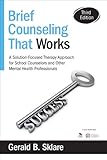Brief counseling that works : a solution-focused therapy approach for school counselors and other mental health professionals / Gerald B. Sklare. [print]
Material type: TextPublication details: Thousand Oaks, California : Corwin, (c)2014.Edition: third editionDescription: xvii, 227 pages ; 23 cmContent type:
TextPublication details: Thousand Oaks, California : Corwin, (c)2014.Edition: third editionDescription: xvii, 227 pages ; 23 cmContent type: - text
- unmediated
- volume
- 9781483332338
- Brief counseling that works
- LB1027.S628.B754 2014
- LB1027
- COPYRIGHT NOT covered - Click this link to request copyright permission:
| Item type | Current library | Collection | Call number | Status | Date due | Barcode | |
|---|---|---|---|---|---|---|---|
 Circulating Book (checkout times vary with patron status)
Circulating Book (checkout times vary with patron status)
|
G. Allen Fleece Library CIRCULATING COLLECTION | Non-fiction | LB1027.5.S553.B574 2014 (Browse shelf(Opens below)) | Available | 31923001897855 |
Browsing G. Allen Fleece Library shelves, Shelving location: CIRCULATING COLLECTION, Collection: Non-fiction Close shelf browser (Hides shelf browser)

|
No cover image available |

|

|

|

|
No cover image available | ||
| BV5055.T687 2010 The Daniel fast for spiritual breakthrough / | BV5055.T689 2002 Fasting for financial breakthrough / | BV5055 .T695 2017 Fasting for spiritual breakthrough : a practical guide to nine Biblical fasts / | BV5055.T696.F378 1996 Fasting for spiritual breakthrough : a guide to nine biblical fasts / | BV5055.T696.P678 2011 <Post radi duhovnogo proryva>. | BV5055.T696.P735 2004 Praktyczny przewodnik po poscie / | BV5055.W34 God's chosen fast /Arthur Wallis. |
Counseling in schools and other settings : problems and solutions -- Origins of solution-focused brief counseling -- Differences and similarities -- Effectiveness -- Core "rules" -- Solution-focused assumptions -- Additional guiding concepts -- Setting Goals -- Opening the first meeting: establishing rapport and explaining the process -- Developing a positive goal -- The miracle question -- "What else" questions -- Establishing well-developed goals: an overview -- Discovering and constructing solutions -- Discovering unrecognized solutions: instances of success -- Empowering clients through recognition of their resources -- Scaling a baseline and progress -- Flagging the minefield: identifying and overcoming obstacles -- Concluding the initial session with a message -- Connecting the pieces -- Components of the first session -- Case study from a mental health setting: session 1 -- Case study transcript from a school setting: session 1 with Pedro -- Abbreviated SFBC session -- Explaining the process -- Determining what the client wants to achieve -- Using scaling to determine clients' view of their present situation -- What's the highest number the client has ever been? -- Writing the message -- A case of an abbreviated SFBC session -- Conducting subsequent sessions -- Subsequent sessions: getting started -- Components of second and subsequent sessions -- Assessing whether further counseling is needed -- Writng the message -- Tools for second and subsequent sessions: flow chart and note sheet -- Subsequent session from a mental health setting -- Subsequent sessions with Pedro from a school setting -- Working with reluctant clients challenging situations -- Helping involuntary clients become customers for counseling -- SFBC with students mandated for counseling in Lieu of disciplinary action -- Turning difficult situations into workable goals -- Expanded applications of solution-focused concepts -- 10-second "counseling" -- Solution-focused counseling referral form -- Using puppets in SFBC -- Using sand trays in SFBC -- Solution-focused group counseling -- Classroom counseling using SFBC methods -- Solution-focused parent-teacher conferences -- Solution-focused guided imagery.
This book offers school counselors an effective and efficient approach to helping students through the use of Solution-Focused Brief Counseling (SFBC). The author presents a focused, step-by-step approach to counseling in schools that leads to rapid, observable change in students. The skills of conducting solution-talk discussions with students can help to reduce arguments, improve relationships, and teach young people to assume responsibility and make better decisions in a supportive environment. This new approach focuses on solutions rather than problems. Students learn how to set goals, rediscover their resources, and repeat past successes. ;
COPYRIGHT NOT covered - Click this link to request copyright permission:
There are no comments on this title.
